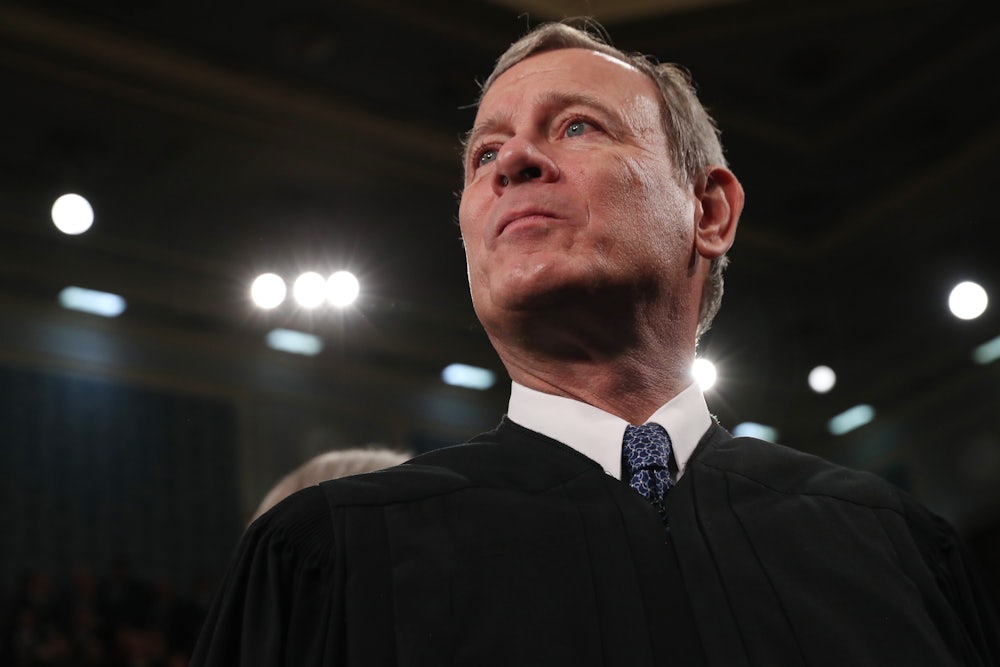As the first term of the Mitch McConnell–engineered 6–3 right-wing Supreme Court supermajority drew to a close last week, most liberal observers expressed qualified relief. With some exceptions—in particular, the last day’s evisceration of Section 2 of the 1965 Voting Rights Act and simultaneous invalidation of California’s donor-disclosure mandate for charities operating in the state—the assessment was that the decisions were, overall, less “conservative” than had been anticipated. The Economist summarized the state of play by announcing (albeit before the last day’s bombshell decisions) that this is a 3–3–3 court now, with an emerging middle consensus centered around Chief Justice John Roberts. This take is oversimplified and much too rosy.
The problem is that these observers have focused on particular substantive issues at stake in the highest-profile cases: the Affordable Care Act was saved, 7–2; religious claims were held not to automatically or presumptively trump laws barring anti-LBGTQ discrimination, again, 7–2; the National Collegiate Athletic Association was subjected to surprisingly strict Sherman Act strictures against price-fixing, applicable to all other “industries,” this time unanimously. Indeed, such results were positive and should be welcomed. But there is an underlying agenda embedded in the fine print of some of the court’s hot-button cases, as well as, more often, in less noted decisions, that’s been overlooked.
What these critics have missed is the conservative justices’ incessant drive to radically enhance the court’s power—power in opposition to Congresses past, present, and future; as well as against the federal executive branch and state and local governments. This historic trend, steadily gaining momentum over the 16-year span of John Roberts’s tenure as chief justice, escalated sharply in several end-of-term decisions. In these, the court’s dominant bloc—which President Ronald Reagan’s solicitor general, Charles Fried, labeled “reactionaries,” not conservatives—asserted for this court power on a level and scale unprecedented in the nation’s history: power de jure as well as de facto.
On June 25, in Trans-Union LLC v. Ramirez, the court threw out a jury’s award of damages for a credit reporting agency’s falsely classifying thousands of individuals as “matches” for federal government–identified “terrorists.” A 5–4 majority held that Congress lacks the power, exercised in the 1970 Fair Credit Reporting Act, to authorize individual consumers to enforce a statutory right to be free from negligently generated, derogatory false credit information. Specifically, the court added a judge-made requirement to the existing statute, stipulating that in order to sue, a consumer must suffer what the court majority termed “actual,” not merely “legal” injury—that is to say, be denied credit or a job—and trace that rejection to the credit reporting agency’s misinformation. As a practical matter, proving such a connection is all but impossible—a reality of litigation surely well known to these canny and experienced conservative justices.
In doing so, the court gutted a half-century-old consumer law and denied Congress authority to act on an indisputably reasonable judgment: that a consumer suffers serious “injury” from a proverbial sword of Damocles dangling over her head, in the form of severely damaging misinformation in a credit reporting agency’s accessible files. For such an injury, Congress determined that judicial redress is an efficacious, “necessary and proper” remedy.
In dissent, Justice Clarence Thomas decried the “remarkable novelty” of the court’s approach. “Never before,” the usually right-leaning Thomas wrote, “has this Court held that legal injury is inherently insufficient to support standing … enforceable in federal court.” Justice Elena Kagan underscored the majority’s overreach: “The Court here transforms standing law from a doctrine of judicial modesty into a tool of judicial aggrandizement.” The decision dulls incentives for business to respect myriad laws enacted by Congress, and does much the same for state legislatures, where remedying and deterring widespread and well-documented abuses against consumers, homeowners, employees, and other individuals is concerned.
In a less-noticed (and more mind-numbingly technical) decision in United States v. Arthrex, the same 5–4 majority invalidated a law designed to insulate, from political pressure, certain patent award decisions—which, Roberts’s majority opinion acknowledged, can be worth “billions” of dollars. The law provided that challenges to existing patents be decided by panels of Commerce Department officials, drawn principally from a roster of 200 administrative patent judges, or APJs, all of whom had been selected by the secretary of commerce. Further, Congress provided that a panel’s decision to sustain or invalidate a patent be final and not reviewable within the Department. But the court nixed Congress’s approach: The majority held that the director of the departmental unit housing the panels must be empowered to review the panels’ decisions, because the director is a presidentially appointed, Senate-confirmed official.
Roberts wrote, “The Constitution … forbids the enforcement of statutory restrictions on the Director that insulate the decisions of APJs from his direction and supervision.” Here, Roberts furthered a line of recent cases that amplify a recently court-created “separation of powers” principle found nowhere in the text of the Constitution. According to this doctrine, regardless of how well-based congressional concerns might be about political interference with sensitive, technical decisions, Congress’s hands are tied.
Instead, the court will enforce its asserted (that is to say, nontextual) constitutional command that the president, or a presidential appointee confirmed by the Senate, must make all executive branch decisions of an as-yet-undefined significance—now extending to matters as granular as resolving thousands of patent challenges. As Justice Stephen Breyer observed in dissent: “Are the President and Congress, through judicial insistence … to be denied the ability to create independent adjudicators? The Founders wrote a Constitution … flexible enough to respond to new needs … over the course of decades or centuries and at the same time, protect certain basic principles.” Drily, Breyer concluded, “A principle that prevents Congress from affording inferior level adjudicators some decision-making independence was not among them.”
Another low-visibility end-of-term decision similarly savaged legislators’ authority, in a manner that broke with decades of precedent, while exposing a vast array of state and federal laws to prohibitive enforcement costs. In Cedar Point Nursery v. Hassid, the new 6–3 conservative majority axed a California regulation requiring agricultural employers to permit union organizers temporarily to use a specific compact location on their property, during four months of the year, one hour before the start of work, one hour at lunch-break, and one hour after work. The court held, for the first time, that even though these arrangements were temporary, brief, and not detrimental to the conduct of covered agricultural businesses, such an “invasion” constituted a “physical taking” of property. Hence, under the Fifth Amendment, the Constitution requires “just compensation” to the property owner. In practice, that requirement will render the regulation unusable for financially stretched state and local governments, thereby depriving union organizers of meaningful access to agricultural workers at the only time they are together and accessible.
As devastating as this anti-union result is likely to be for agricultural workers, the doctrinal reversal the court engineered to reach that result could cut far more broadly. As Justice Breyer observed in his dissent, the decision obliterated a till-now sharp “permanent/temporary access distinction,” under which “the law has not … converted all temporary-access-permitting regulations into per se takings requiring compensation.” Such temporary access requirements are, Breyer explained, essential to untold, basic governmental activities, “ranging from examination of food products to inspections for compliance with preschool licensing requirements,” to workplace environment safeguards, coastal wetland protections, and a long list of others. All such programs now face exposure to lawsuits by disgruntled regulated entities—expense, harassment, and diversion that few state and local entities can handle.
The most flagrant demonstration of the right-wing majority’s power-grabbiness came with the term’s last-day blockbuster, upholding two new Arizona voter access restrictions that threaten—not coincidentally—to reduce minority votes. The decision was widely noted, and panned, for Justice Samuel Alito’s elaboration, for a 6–3 majority, of an interpretation of Section 2 of the 1965 Voting Rights Act that will complicate and frequently doom future challenges to assaults on ethnic minorities’ electoral opportunities.
But at least equally noteworthy is the sheer audacity of the conservative justices’ readiness to ignore, twist, and flat-out contravene unambiguous instructions that multiple bipartisan congressional majorities painstakingly inscribed in the text of this historic statute.
Justice Kagan devoted the overwhelming bulk of her 85-page dissent to detailing the “textualist” perfidies committed by Justice Alito’s attempts to skirt the obvious import of Section 2’s clear and straightforward words (emphasis added):
No voting qualification or prerequisite to voting or standard, practice, or procedure shall be imposed or applied by any State or political subdivision in a manner which results in a denial or abridgement of the right of any citizen of the United States to vote on account of race or color.
This terse language, Kagan explained, “prohibits not just the denial but also the abridgment of a citizen’s voting rights on account of race.” The “results in” phrase, she pointed out, “prohibits, without any need to show bad motive, even facially neutral laws that make voting harder for members of one race than of another, given their differing life circumstances.” Rather than apply these categorical prohibitions, Kagan wrote, “The majority instead founds its decision on a list of mostly made-up factors, at odds with Section 2 itself ... to sap the Act’s strength, and to save laws like Arizona’s.” Alito’s circumnavigation of the law’s text, she concludes, “mostly inhabits a law-free zone.”
The message here is clear enough: It does not matter what Congress prescribes in legislation, if we, the life-tenured majority on this, the nation’s highest court, disapprove of Congress’s handiwork. If we cannot come up with a credible Constitution-based excuse for striking those provisions down, we will simply turn to the power justified two centuries ago by Chief Justice John Marshall as this court’s responsibility to “say what the law is.” We will use that raw power to ignore or rewrite unwanted statutory provisions, to render them ineffectual, or to produce results directly opposite to what they mean.
This is a level of contempt for the decisions of elected officials unmatched even by the notorious anti-regulatory constitutional jurisprudence of the so-called “Lochner court” of the first third of the twentieth century. And it claims an anti-democratic judicial supremacy wholly incompatible with the Framers’ constitutional design for the judiciary as what Alexander Hamilton famously labeled “the least dangerous branch.” The power grab is on, and the danger is very real.








